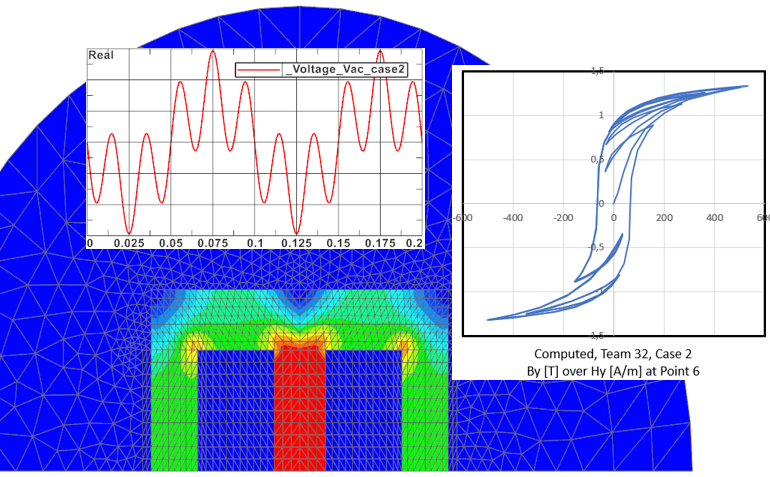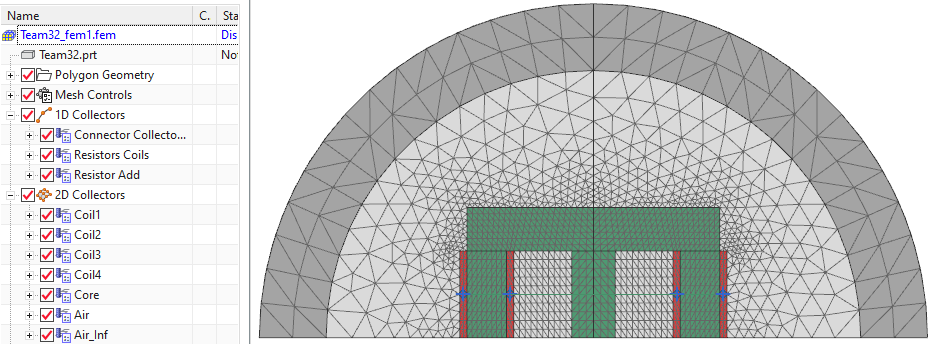In this example we model magnetic hysteresis effects using the Jiles-Atherton vector hysteresis model.

Initial Situation
Hysteresis Modeling
The used example is the TEAM 32 test case whose setup is shown in the below picture. The following picture shows the expected hysteresis loop as it results from alternating magnetic fields at point C6.
Picture: TEAM 32 Testcase and expected hysteresis loop


The dimensions and material data are taken from TEAM benchmark problem 32. Some of the input data is:
Coils: Copper, 90 turns, Electric Conductivity 58e6 S/m
Core: Magnetic, nonlinear, with hysteresis parameters.
More background information about this test example and available measurements can be found in the reference paper [1]. The model consists of two coils and a core. In the paper there are 4 cases described. We model case 2: The two coils are connected in series. The series is supplied by a sinusoidal voltage of 13.5 V (peak value). Additionally there is a fifth harmonic applied with same phase.
Appropriate Method
Jiles Atherton Vector Hysteresis Model
For the precise computation of hysteresis in NX Magnetics there is an implementation of the Jiles Atherton Vector Hysteresis Model. Background and the used algorithms can be found in [3] and [4].
The files for this example are found in folder ‘Tutorials/10.Features/10.5MagHysteresisJilesAtherton’. The model is already build and ready to solve in subfolder complete. Following we walk through some interesting parts of the model.
In Simcenter, open the Sim file ’Team32 sim1.sim’. Set the displayed part to the Fem file.
Check the existing meshes and physical properties. Notice also, there are 1-D circuit elements included to connect the coils in series and apply additional resistances. Two remaining coil connectors are connected with the voltage load as seen later in the Sim file.
Picture: existing meshes, physical properties and 1-D circuit elements

To model magnetic hysteresis by Jiles-Atherton the material description must have JilesAtherton-Parameters. We check this for the core material: Edit the core material (t32 Core mat hyst) and open register ’Electromagnetic’.
Picture: Material Dialogue with Jiles Atherton parameters
Check the load: Notice, it is a voltage load being applied to the two coil connectors. The load is defined as ’Analytic’, because this allows to add the fifth harmonic simply by writing the desired formula as seen in the below picture.
Picture: Sine voltage load with added fifth harmonic
Finally, solve the solution. Solve time will be about 3 minutes for the 200 time steps and nonlinear iterations.
Result
Simulation - Measurement
We make a graph b over h and demonstrate the hysteresis effect. It shows the desired magnetic hysteresis curve. The computed curve (below blue) agrees quite well to the reference one (below black).
Picture: Expected (black) and computed (blue) Hysteresis Loss curve

References:
- [1] Description of TEAM Problem: 32. "A Test-Case for Validation of Magnetic Field Analysis with Vector Hysteresis", at the following Link.
- [2] Experimental data to the TEAM 32 benchmark is available at this link.
- [3] "Using a vector Jiles-Atherton hysteresis model for isotropic magnetic materials with the FEM, Newton-Raphson method and relaxation procedure", Guérin C., Jacques K., Sabariego R. V., Dular P., Geuzaine C. and Gyselinck J.
- [4] "Incorporation of a Jiles-Atherton vector hysteresis model in 2D FE magnetic field computations, Application of the Newton-Raphson method", Gyselinck J., Dular P., Sadowski N., Leite J., Bastos J.P.A.



